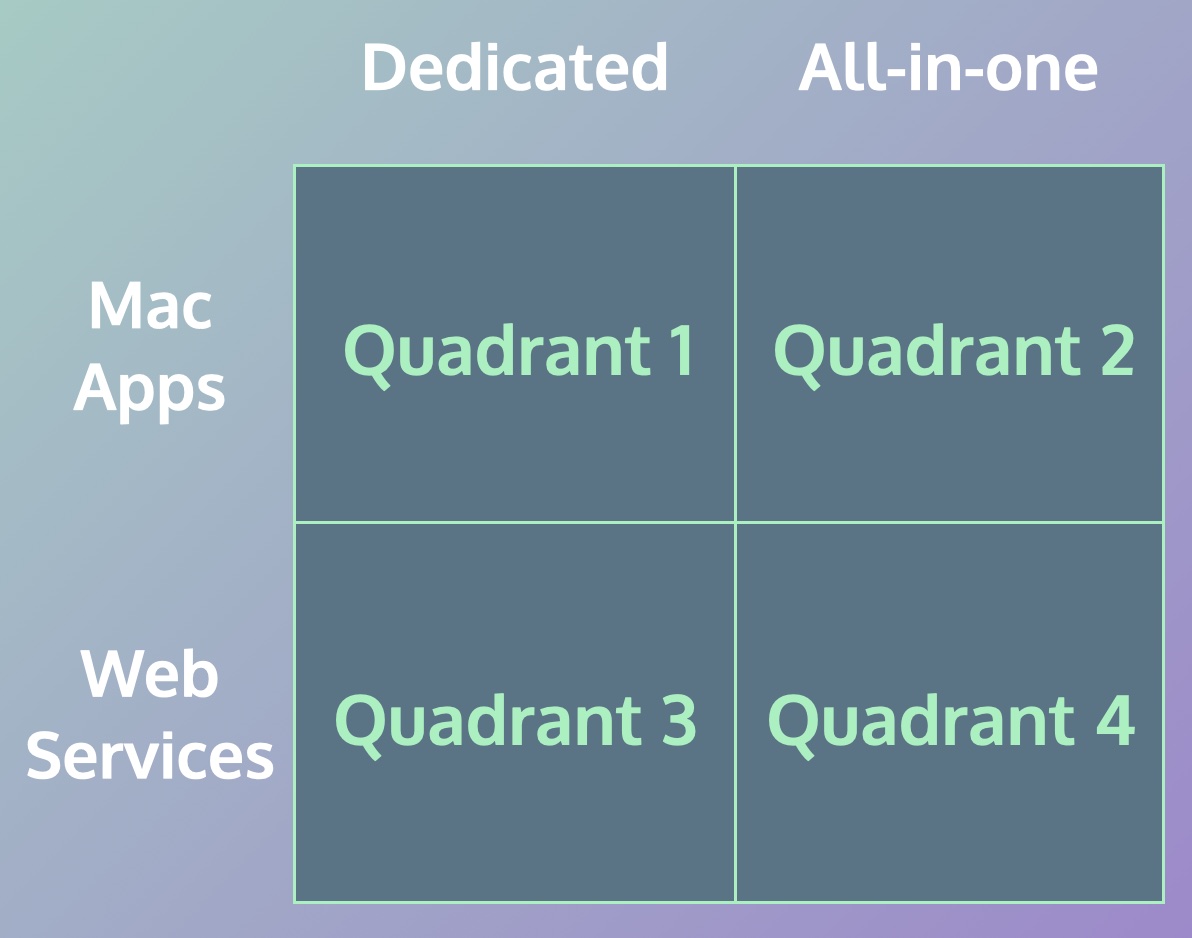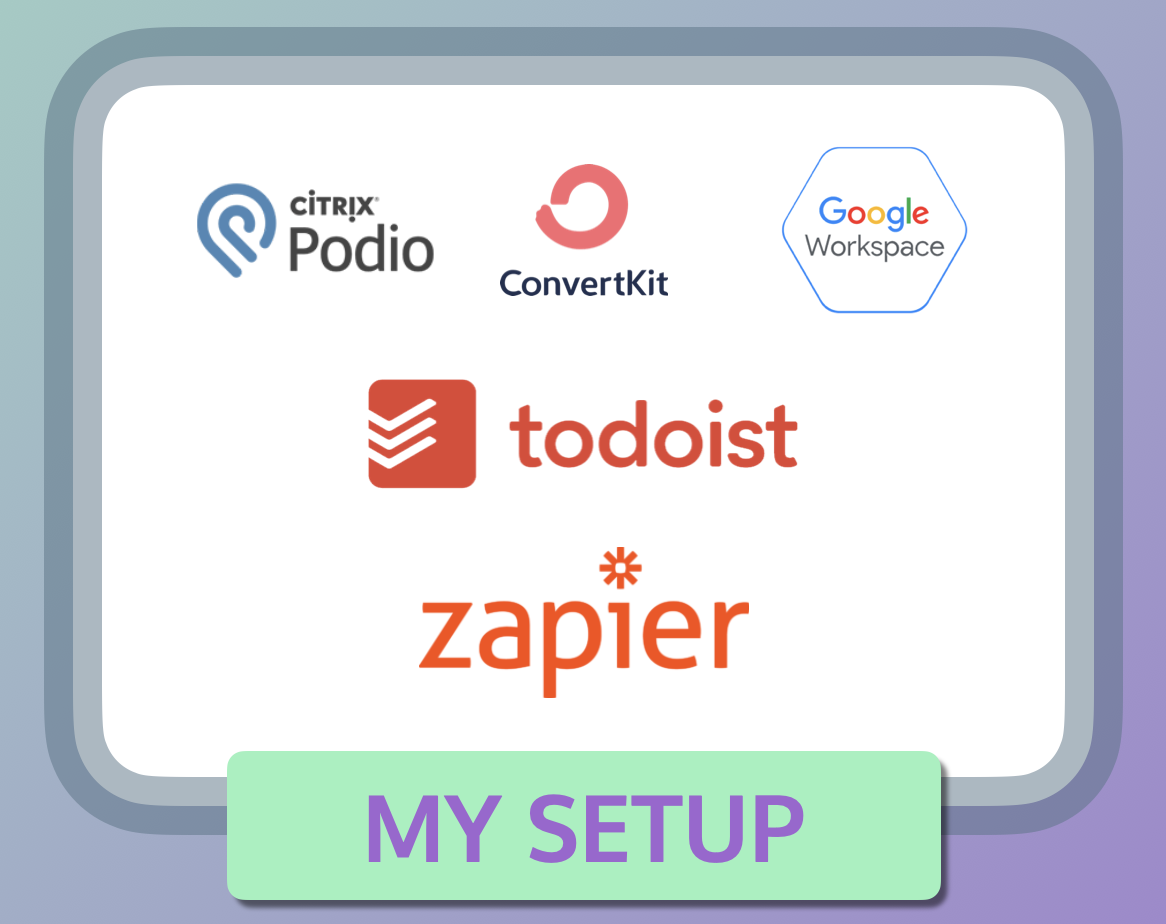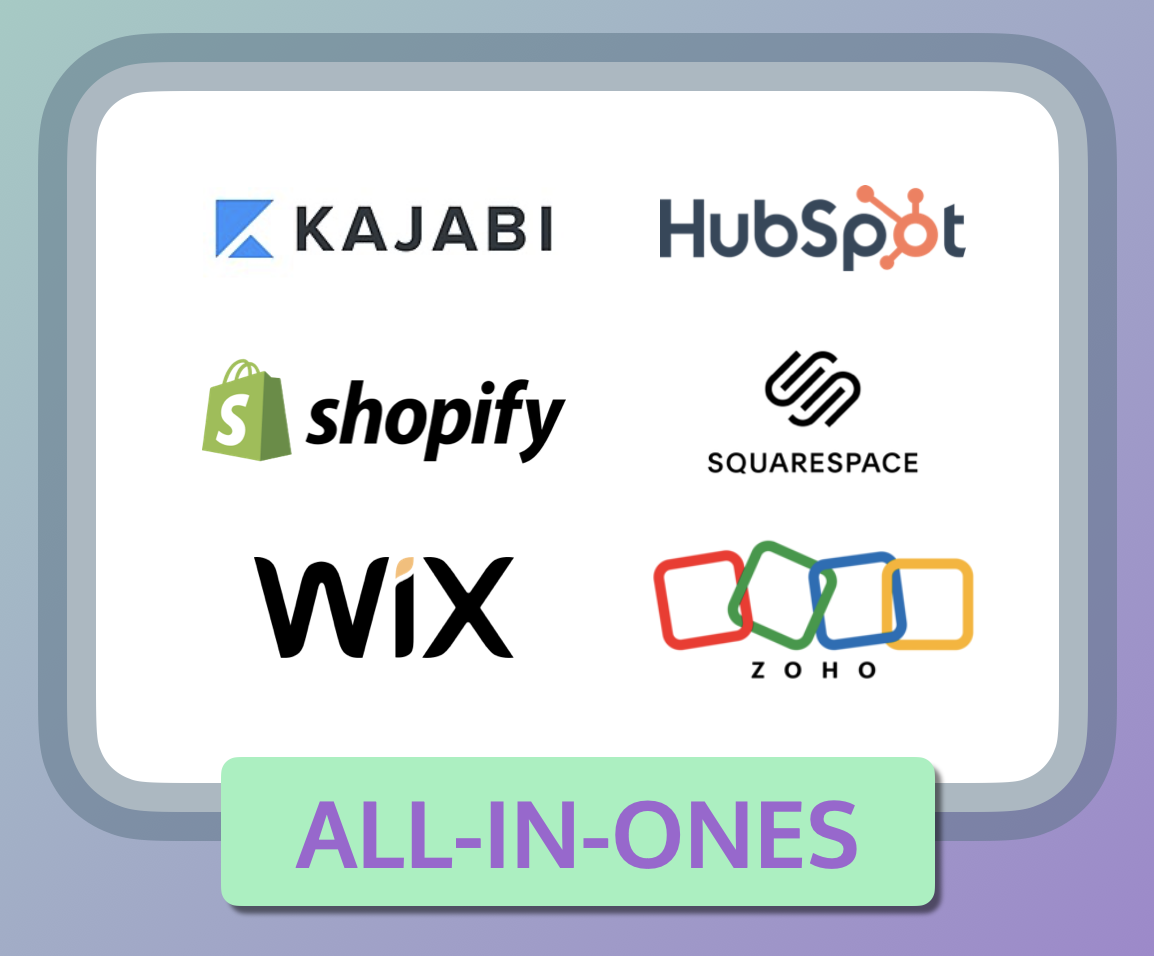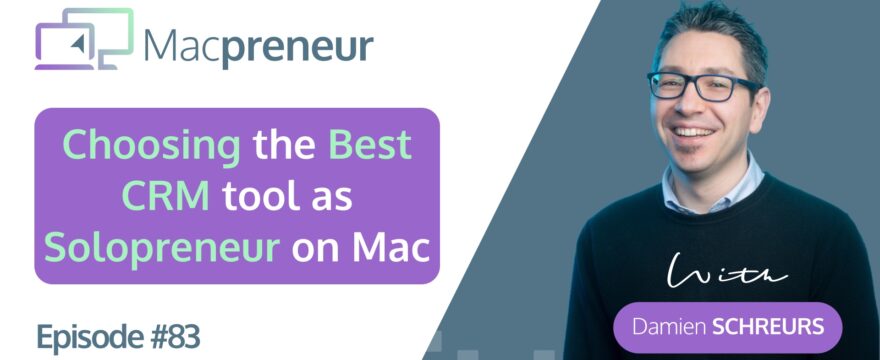TL;DR
In this episode, you’ll discover a framework that will help you choose the best Customer Relationship Management (CRM) solution for your solopreneur business.
Tools mentioned in this episode:
- Daylite CRM
- Podio: https://podio.com/
- Google Workspace: https://workspace.google.com/
- ConvertKit: 14-day free trial with my affiliate link
- Todoist: https://todoist.com
- Zapier: https://zapier.com
- Kajabi: https://kajabi.com
- Hubspot: https://hubspot.com
- Shopify: https://shopify.com
- SquareSpace: https://www.squarespace.com
- Wix: https://www.wix.com
- Zoho CRM: https://www.zoho.com
Affiliate disclosure
Hey there! Quick heads-up: Some of the links in this post might be special. Why? Because if you click on them and make a purchase, I earn a small commission at no extra cost to you. It’s like a virtual high-five for recommending stuff I love! So, thank you for supporting me and the Macpreneur podcast! Remember, I only promote products that I genuinely believe in. Now, let’s dive back into the fun stuff!
Introduction:
In today’s fast-paced business world, managing client relationships can be a challenging task, especially for solopreneurs.
Juggling multiple client calls, emails, and notes can quickly become overwhelming and lead to a disorganized sales pipeline.
However, fear not, as there are powerful Mac apps and web services available that can help you stay organized, informed, and connected with your clients.
In this blog post, we will explore different CRM solutions and discover the best tools perfectly suited for your business type.
By the end, you’ll have actionable tips to simplify your client relationships and drive success.
So let’s dive in!
The Allure of CRM Solutions:
At the beginning of our journey as solopreneurs, managing client relationships can be a challenging task.
In this episode, I highlight the importance of having a system in place to keep track of conversations, understand sales pipeline stages, and remember past and future interactions. In my quest for the right CRM solution, I discovered that most tools were geared towards large enterprises, leaving solopreneurs with limited options.
However, in recent times, the landscape has shifted, providing a wide range of solutions that cater specifically to the needs of individual entrepreneurs.
The Search for the Perfect CRM Solution:
When it comes to choosing the right CRM solution, we need to consider four key factors:
- customization
- automation
- compliance,
- and ease of use
To help you simplify the situation, the best is to categorize the options into four quadrants, based on whether they are dedicated Mac applications or web services, and if they offer all-in-one solutions or multiple tools for client management.

Quadrant 1: Dedicated Mac Applications
For solopreneurs who are just starting out and want a cost-effective solution, dedicated Mac applications can be a great option.
Utilizing built-in Mac applications such as Contacts, Mail, Notes, and Reminders, solopreneurs can create a makeshift CRM system.
I recommend leveraging the Notes field in Contacts to track conversations, using Flags in Mail to track sales pipeline stages, and utilizing tags in Notes to track the sales pipeline and other important details.
While this solution may not be as scalable or easily delegated, it provides a free and convenient starting point for solopreneurs.
Quadrant 2: All-in-One Mac Applications
If you’re looking for a comprehensive CRM solution made for the Mac yet with cloud synchronization and collaboration capabilities, Daylite by Market Circle is a strong contender.

Daylite offers various plans tailored to service-based solopreneurs, starting at $30 per month.
With features like contact management, calendar integration, task management, email communications, and sales opportunity tracking,
Daylite provides a native Mac experience and seamless integration with Apple applications.
However, it’s important to consider the learning curve and the pricing, especially if you have multiple users or require additional features.
Quadrant 3: Dedicated Web Services
Dedicated web services are ideal for solopreneurs who prioritize flexibility and modular solutions.
By combining different tools like Podio, ConvertKit, Google Workspace, Todoist, and Zapier, I created a tailored CRM system that best fits my needs.

Here is my current setup:
- Podio for lead and client management
- ConvertKit for email marketing,
- Google Workspace for contact and email management,
- Todoist for task management,
- and Zapier to glue all that together
While this solution offers excellent customization options and best-in-class tools, integration and cost considerations should be kept in mind.
Quadrant 4: All-in-One Web Services
For those seeking a unified interface and seamless integration, all-in-one web services offer the perfect solution.

Different services such as Kajabi for digital products, HubSpot for service-based businesses, and Shopify for e-commerce businesses provide a single login and interface.
If you’re trying to do a little bit of everything, then I would say go with more all-rounded options like Squarespace, Wix, or Zoho.
These services offer a wide range of features, but it’s important to note that they may not have the same level of specialization as dedicated tools. Additionally, relying on a single provider means putting all your eggs in one basket, so security and backup strategies should be considered.
Choosing the Right CRM Solution for You:
Ultimately, the best CRM solution for your business will depend on three main factors:
- your business type and compliance requirements
- your comfort with technology and integration,
- and your specific needs for customization and automation.
By analyzing the four quadrants and considering your unique business needs, you can make an informed decision and simplify your client relationships.
Conclusion:
Managing client relationships effectively is crucial for the success of solopreneurs.
By utilizing the right CRM solution, you can stay organized, informed, and connected with your clients.
Whether you opt for dedicated Mac applications, all-in-one Mac applications, dedicated web services, or all-in-one web services, there is a solution out there that will align with your unique business needs.
Evaluate your options, test them out, and find the perfect CRM solution that will help you streamline your solo business and drive growth.
Cheers to building strong client relationships and achieving your goals!
FULL TRANSCRIPT (Click here)
Teaser
Imagine juggling multiple client calls, emails, and notes, feeling overwhelmed and unsure about who’s where in your sales pipeline. You are not alone. As solopreneurs, managing client relationships can be a messy juggling act. But fear not because today we will explore powerful Mac apps and web services that will help you stay organized, informed, and connected with your clients.
By the end of this episode, you will have a clear understanding of different CRM solutions, discover tools perfectly suited for your business type, and walk away with actionable tips to finally simplify your client relationships. I’ll unpack all of this after the intro.
Welcome
Hello, hello, and welcome to episode 83 of the Macpreneur podcast. Whether it’s your first time tuning in or you’re a long-time listener, I appreciate you taking some time out of your busy solopreneur schedule to join us.
Today, I’d like to extend my thanks to JFBmusic from the US, who left a five-star rating and review on Apple Podcasts. The title of the review is ‘Simple and to the point, great info’. Here is what JFBmusic wrote: ‘Macpreneur is a recent discovery for me. I appreciate the simplicity of Damien’s explanations and, even though it’s audio-only, it’s easy to follow along at your Mac while you listen to his tips. I also like that the episode length is usually less than 15 minutes, making for a concise, information-packed short lesson. Merci, Damien’.
So, thank you very much for these kind words. I’m truly glad that you’re able to follow along easily despite the audio format. Since the beginning of season two, I’ve been recording the podcast as a video that then gets published on YouTube. Regardless of the B-roll images or videos I use for the YouTube audience, I always strive to be mindful of the pure listening experience. On that note, if you’re a long-time listener, I’d be extremely grateful if you could head over to Apple Podcasts and leave a review telling me about your favorite episode of the show so far. I will take a look and share some of the favorites next week. If you’ve never done this before, open Safari on your iPhone and visit macpreneur.com/iTunes, which will then redirect you to Apple Podcasts. Simply scroll to the bottom of the show page where you will be able to select a star rating and then tap ‘write a review’.
Managing Customer Relatioships is hard
When I launched EasyTECH in 2013, I was still working part-time for my previous employer. Juggling a 9-to-5 job while dealing with the first prospects and clients was no easy task.
I quickly realized that I needed a system to help me keep track of conversations across various channels. I also needed to understand where each lead was in my sales pipeline and remember both past and future interactions. These could be a discovery call, a diagnostic visit, or a training or consulting session.
At that time, it took me a while to find the right tools. Most were geared towards large enterprises, not solopreneurs. However, nowadays, it’s the opposite. There is such an abundance of tools that deciding which one to pick can be difficult and overwhelming.
The 4 things to look for in a potential CRM
The good news is that you are in the right place, my Macpreneur friend. The goal of this episode is to help you find the right tool, or set of tools, that will align with your unique business needs.
Whether you’re offering services, selling digital products, or starting an e-commerce business, there are four things that you should look for in a potential CRM, or Customer Relationship Management solution.
The first thing to consider is customization. Having the ability to adapt the tool to your specific needs is very useful.
The second factor is automation. Being able to configure workflows that will eliminate repetitive tasks will be a time saver in the long run.
The third aspect is compliance with any regulations that your business is subject to. For example, it could be GDPR in Europe for me, but for you in the U.S., it could be HIPAA. There are many other regulations all around the world.
Finally, the tool should also be easy to learn and use.
2 by 2 matrix to classify CRM solutions
As I mentioned earlier, there are numerous solutions available. One way to simplify this vast landscape is by categorizing them into four major groups.
Consider a 2×2 matrix, with the top row designated for Mac applications and the bottom row for web services. Looking at the columns, the left column would represent dedicated solutions or multiple tools to manage our client’s relationships, while the right column would represent all-in-one solutions.
Essentially, the top left quadrant, or quadrant one, would consist of dedicated Mac applications. The top right quadrant would comprise all-in-one Mac applications. The bottom left quadrant would include dedicated web services, and the bottom right quadrant would encompass all-in-one web services. We will explore these four quadrants in this episode.
Dedicated Mac apps: Contacts, Mail, Notes, Reminders
Let’s begin with quadrant one, which involves dedicated Mac applications.
So, who would find this solution acceptable?
I would suggest it’s suitable for solopreneurs just starting out, those who don’t wish to invest money or time in learning something new.
Indeed, it’s feasible to piece together a solution using the built-in Mac applications provided by Apple.
These include the Contacts app, the Mail app, Notes, and Reminders.
In the Contacts app, for example, you can utilize the Notes field to track dates and conversations. Additionally, you can use Groups to monitor the sales pipeline stage. Hence, you could have a group for Qualify, another for Discovery, and so forth.
In Mail, the same principle applies, but you can use flags to track the sales pipeline stage as well.
In Mail, you can also employ what are known as Smart Mailboxes. Instead of a simple mailbox, it’s an automatic filter based on a rule that you establish.
An example of such a rule could be that any message received from or sent to a specific lead or customer would be grouped together.
In the Notes app, you can create one note for each lead or customer to track interactions. You can manually record dates, phone calls, Zoom meetings, and message exchanges. You can even use tags in Notes to track the sales pipeline stage.
Similarly to Mail, you can create smart folders in Notes based on the tags associated with your note.
You could have a tag for the discovery phase, the qualification phase, and the conversion phase, for instance.
You could also add specific tags for the lead magnets that they’ve signed up for and the products and services they’ve purchased.
Returning to the topic of tracking email communications with leads inside notes, a useful tip is that starting from macOS 13 Ventura, you can drag and drop a message from Apple Mail to a note. This action will automatically create a link to the original message, meaning that in Notes, you simply click on the link to reopen the associated email message.
To track tasks, you could use checklists, but you would lack alerts and notifications.
For this, I recommend using the Reminders app. A nice feature of the Reminders app is the ability to create templated lists with predefined tasks. You can create a template for your sales pipeline, with tasks for the discovery phase, the qualification phase, and the conversion phase.
Once you’ve created the templated list, you can click on ‘File’, then ‘Save as a template’, and then you can click on the ‘Create’ button.
To reuse a templated list of tasks, you simply click on ‘File’, then ‘View template’. You select the one you want and then click on ‘Create list’.
Pros and cons of separate Mac apps
Okay, so what are the advantages and disadvantages of having separate native Mac applications?
A significant advantage is that it’s free and comes with your Mac as part of macOS. It also offers synchronization via iCloud, making everything you do available on your iPhone, iPad, and other Macs you might own.
The main disadvantages are that it’s not easily scalable, and delegation can be challenging. While possible with Notes and Reminders, it becomes quite difficult for Email and Contacts.
All-in-one Mac app: Daylite CRM
Let’s now explore the second quadrant, the one with the all-in-one Mac application. Based on my research, there is only one contender: Daylite, developed by Market Circle.
Daylite is primarily for service-based solopreneurs who desire cloud synchronization, the ability to work offline, and collaboration with others in the Apple ecosystem. The base plan, starting at 30 dollars per month, offers the ability to manage contacts, calendars, tasks, and email communications.
If you wish to track sales opportunities and maintain a sales pipeline, the cost increases to 50 dollars per month. There is another plan, the CRM plus project management, which is primarily for tracking projects when you provide services, priced the same.
For those desiring the complete package, which includes managing contacts, calendars, tasks, mailings, sales opportunities, and project management, the cost is 70 dollars per month or seven hundred dollars per year for one person.
Pros and cons of Daylite
So what are the big advantages of Daylite? Well, it’s possible to work offline, and it is customizable so it can fit a wide variety of industries.
It obviously has a native Mac feel with the sidebar, the column view, and it synchronizes iPhones, iPads, and other Macs too.
And since it’s a Mac app, it integrates very well with native Apple applications like Apple Mail, Contacts, and Calendars.
But not only that, it also interacts and integrates with web services, either directly through plugins or via Zapier.
The main disadvantage of Daylite is that it’s quite pricey because for one user, the starting point is seven hundred dollars. And if you want to have more users, for instance, if you want to add a VA or something like that, you have to add five hundred dollars per user per year.
And also, the base package covers 75 opportunities and projects combined, which means that if you need more than a combination of 75 leads and clients, assuming just one project per client, then you will need to pay extra. Market Circle sells packs of 20 opportunities and projects combined for one hundred dollars per year.
And some integrations require another subscription that ranges between $13 per month and $35 per month per user.
The second thing is the learning curve. So I’ve never used it, but looking at the screenshots, there will be a learning curve, that’s for sure.
And the good news is that there are plenty of video tutorials and prerecorded webinars on the Market Circle website.
And then the last thing is that Daylite is not HIPAA compliant. HIPAA is the Health Insurance Portability and Accountability Act, a US federal law that governs the protection of sensitive patient health information.
So if your solo business is subject to HIPAA, you can’t use Daylite CRM.
Dedicated web services
So, in the bottom left quadrant, we have dedicated web services.
This is a good solution for solopreneurs who want the best-in-class and are comfortable with gluing things together.
Now, let me quickly explain my setup. I’m using Podio, ConvertKit, Google Workspace, Todoist, and Zapier.
Podio
I use Podio to store all the leads, all my clients. I manage the sales pipeline and all the projects. Everything is in Podio.
What I like about Podio and why I chose it is because it’s very easy to define custom fields and also to make calculations.
For instance, if I visit a client’s contact page in Podio, I can see at a glance how many projects I have made for them, the total revenue that they generated. I have also made some calculations to get the profitability and return on investment when I take into account the time that I spent during the prospecting phase.
On top of that, you have different views: calendar views and Kanban views. It also integrates very well with Google Calendar, so anything that I define in Podio will show in Google Calendar.
It has built-in automation workflows and it integrates very well with Zapier for automation and data transfer with other applications.
ConvertKit
The next one is ConvertKit, so I use that for my email marketing. I really like the tagging systems, it’s possible to create segments, landing pages, forms; it’s a really good way to create broadcasts.
It’s almost a one-click if you want to resend to the people who did not open the first time you send a broadcast.
You can do email sequences, visual automation with branching, and delays.
You can even create rules. So, for instance, whenever an EasyTECH lead becomes a customer, it gets tagged in ConvertKit as “EasyTECH” and for me, that means that person is a client.
Over the years, they have added new features like the ability to sell products and sell memberships.
You can try ConvertKit for free for 14 days using my affiliate link. You just visit macpreneur.com/convertkit, C O N V E R T K I T in one word.
So once again, macpreneur.com/ConvertKit.
Google Workspace
Then I’m using Google Workspace, and there are two main tools for managing client relationships: Google Contacts and Gmail.
In Google Contacts, it’s very easy to apply tags. But what I really like is that when you access a contact in Google Contacts, from that page, you can see the latest email conversation that you have.
So it’s a small trick, right? If you don’t want to get sucked into your inbox because you want to send an email to someone but you don’t want to look at your inbox.
You would just want to contact somebody to send a message. Don’t open Gmail, open Google Contacts, search for the person, and locate the latest conversation. And then from there, you can just click on it, and it will automatically open that message, bypassing the inbox altogether.
And I really like Gmail because it’s possible to automatically apply labels using filters, the search is fantastic, and they have add-ons.
From the Gmail view, it’s possible on the sidebar, on the right side, to look at the calendar, to convert emails to tasks in Todoist, and so on.
Todoist
And talking about tasks, yeah, Todoist is my task manager of choice.
I’ve tried a bunch, and I don’t know, but that’s the one that really clicked with me.
I started with a free plan, and now I’m paying for it.
It’s available on all my devices. I can do tagging, I can do projects, I can do sub-projects, I can group tasks inside sections within a project, so it could be used as well for the different stages of the sales process.
We have a list view, Kanban view, and like reminders, it’s possible to create and reuse personal templates, but it requires the desktop or the web application. And also, it’s not super simple because you need to save a CSV file and then re-import a CSV file.
On the flip side, it has excellent native integration with a lot of other web services, and if for any reason it was not natively integrated, then you can still use Zapier, which is basically the tool that I use to glue everything together.
Zapier
So, with Zapier, you can create what they call Zaps, which are automation workflows.
In my case, I use Zapier to automatically copy data between Podio, ConvertKit, Google Workspace, and Todoist.
For a practical example, when a lead fills out the contact form on the EasyTECH website, Zapier will automatically create a new contact in Google Contacts, then a new lead in Podio, and a new task in Todoist.
On the contact form at the bottom, there is a checkbox: “Do you want to receive Apple security alerts?” If the leads tick that box, Zapier will also add that person to the proper form in ConvertKit, which will then trigger the double opt-in email.
For me, it’s a huge time saver and also a huge stress saver.
Pros and cons of dedicated web services
So, what are the advantages and disadvantages of having dedicated web services? The big advantage, of course, is the flexibility and modularity.
You can have the best-in-class solutions for the different things that you want to do, and you don’t have all your eggs in one basket, basically.
The disadvantage is that you need to be able to integrate them together. So, you need something like Zapier to glue them together. And that can be challenging at times.
Moreover, it can also be pricey. So, I made a calculation and with my current setup, it totals at six hundred and twenty-four dollars per year.
All-in-one web services
Okay, so let’s finish off with the last, the bottom right quadrant, which would be all-in-one web services.
So, this is recommended for people who want a single interface and something that runs everywhere.
And so, there are different solutions that I have found that fit different kinds of business models.
For instance, if you mostly sell digital products, then I would recommend you to have a look at Kajabi. It seems that it’s a great platform for online courses. You can do memberships, and they have basic CRM capabilities as well.
If you do services, then I would say, have a look at HubSpot. If I started EasyTECH today, I might be tempted to go with HubSpot rather than Podio.
Now, if you are mainly doing e-commerce, for me the champion today is Shopify.
If you’re trying to do a little bit of everything, then I would say go with more all-rounded options like Squarespace, Wix, or Zoho.
Zoho offers multiple tools that you can combine together.
Pros and cons of all-in-one web services
The big advantage, obviously, of these is that you have one web service, so you have one login, it’s one interface.
And because everything is together, there is seamless integration between all the different modules.
And it’s also possible to find tailored solutions for specific business models.
On the flip side, having just one login means that you better secure it very well.
So strong password and two-factor authentication.
And you also put all your eggs in one basket. And so if the web service provider shuts down or gets acquired, it can affect all the components of your customer relationship management solution.
Now you may know this saying, right? “Jack of all trades, master of none.” All-in-one solutions usually have one or more strong suits. But then the other components are not as full-featured as a dedicated tool could be.
And so, for instance, with Squarespace, it’s possible to create email lists and email campaigns, but based on my little experience, it is less powerful than ConvertKit.
And then, it’s also possible to pay more than what you actually need, especially at the beginning. But then, on the flip side, and I’ve noticed that with HubSpot, for instance, as soon as your business grows and you need to deal with more and more clients and prospects and so on, it can get very expensive very quickly.
One more thing
OK, one more thing before the recap.
If you choose to go the all-in-one route, make sure to regularly export or backup your contact list. Sure, most all-in-one web service providers will do internal backups so that they could restore anything that you might delete accidentally. However, it’s even better if you have your own copy of the data in case something catastrophic happens on the provider’s side or if you want to migrate to another service.
On the other hand, if you choose dedicated apps or dedicated web services, it’s highly likely that your contacts will be in multiple places. The key here is to decide upfront what will be the source of truth. So, the one place where you will always be able to find all your contacts.
For EasyTECH, it’s Podio that contains both the leads and the customers because it fits much better with the nature of my business.
And for Macpreneur, it’s still in the early stages and at the moment, I’m using ConvertKit as the source of truth. But because I plan to sell digital products and coaching services with Teachable, I might end up centralizing everything into something in between, like a Google Sheet using Zapier Automation.
Recap
So, to recap, the best CRM solution for you will depend on three main factors:
- The business type and the associated compliance requirements
- Your comfort with technology
- Your specific needs for customization and automation
I hope this episode has given you a useful framework to navigate the flurry of CRM solutions available today.
If you found this episode helpful, please share it with a fellow entrepreneur and tag me on Instagram. My handle is @MacpreneurFM.
360° Tech Diagnostic Service
And if you’re ready to streamline your solo business but don’t know where to start, sign up for my 360-degree tech diagnostic service. After filling out a comprehensive assessment form, we’ll have a Zoom call during which I will give you my top three recommendations, including tools and services to consider.
After the call, you will receive a summary report with the points that we discussed and all the necessary links.
And if you decide to work with me one-on-one after that, I will deduct the diagnostic fees from the first coaching pack that you purchase. To learn more about the 360 TECH Diagnostic Service, just visit macpreneur.com/diagnostic or click the link in the show notes.
Next and outro
So that’s it for today.
In the next episode, I will explore some time-saving practices for creating and managing content for a blog, podcast, or social media.
And until next time, I’m Damien Schreurs, wishing you a great day.






